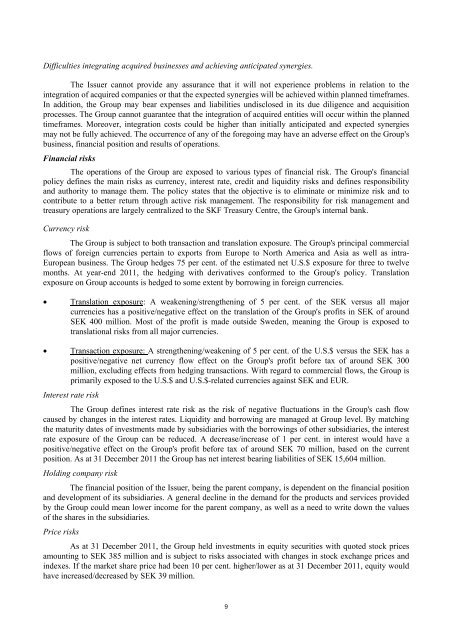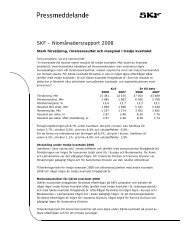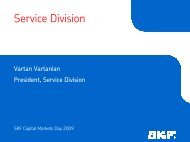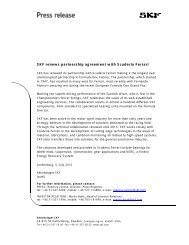Prospect, pdf - the SKF site for the capital market
Prospect, pdf - the SKF site for the capital market
Prospect, pdf - the SKF site for the capital market
Create successful ePaper yourself
Turn your PDF publications into a flip-book with our unique Google optimized e-Paper software.
Difficulties integrating acquired businesses and achieving anticipated synergies.<br />
The Issuer cannot provide any assurance that it will not experience problems in relation to <strong>the</strong><br />
integration of acquired companies or that <strong>the</strong> expected synergies will be achieved within planned timeframes.<br />
In addition, <strong>the</strong> Group may bear expenses and liabilities undisclosed in its due diligence and acquisition<br />
processes. The Group cannot guarantee that <strong>the</strong> integration of acquired entities will occur within <strong>the</strong> planned<br />
timeframes. Moreover, integration costs could be higher than initially anticipated and expected synergies<br />
may not be fully achieved. The occurrence of any of <strong>the</strong> <strong>for</strong>egoing may have an adverse effect on <strong>the</strong> Group's<br />
business, financial position and results of operations.<br />
Financial risks<br />
The operations of <strong>the</strong> Group are exposed to various types of financial risk. The Group's financial<br />
policy defines <strong>the</strong> main risks as currency, interest rate, credit and liquidity risks and defines responsibility<br />
and authority to manage <strong>the</strong>m. The policy states that <strong>the</strong> objective is to eliminate or minimize risk and to<br />
contribute to a better return through active risk management. The responsibility <strong>for</strong> risk management and<br />
treasury operations are largely centralized to <strong>the</strong> <strong>SKF</strong> Treasury Centre, <strong>the</strong> Group's internal bank.<br />
Currency risk<br />
The Group is subject to both transaction and translation exposure. The Group's principal commercial<br />
flows of <strong>for</strong>eign currencies pertain to exports from Europe to North America and Asia as well as intra-<br />
European business. The Group hedges 75 per cent. of <strong>the</strong> estimated net U.S.$ exposure <strong>for</strong> three to twelve<br />
months. At year-end 2011, <strong>the</strong> hedging with derivatives con<strong>for</strong>med to <strong>the</strong> Group's policy. Translation<br />
exposure on Group accounts is hedged to some extent by borrowing in <strong>for</strong>eign currencies.<br />
� Translation exposure: A weakening/streng<strong>the</strong>ning of 5 per cent. of <strong>the</strong> SEK versus all major<br />
currencies has a positive/negative effect on <strong>the</strong> translation of <strong>the</strong> Group's profits in SEK of around<br />
SEK 400 million. Most of <strong>the</strong> profit is made outside Sweden, meaning <strong>the</strong> Group is exposed to<br />
translational risks from all major currencies.<br />
� Transaction exposure: A streng<strong>the</strong>ning/weakening of 5 per cent. of <strong>the</strong> U.S.$ versus <strong>the</strong> SEK has a<br />
positive/negative net currency flow effect on <strong>the</strong> Group's profit be<strong>for</strong>e tax of around SEK 300<br />
million, excluding effects from hedging transactions. With regard to commercial flows, <strong>the</strong> Group is<br />
primarily exposed to <strong>the</strong> U.S.$ and U.S.$-related currencies against SEK and EUR.<br />
Interest rate risk<br />
The Group defines interest rate risk as <strong>the</strong> risk of negative fluctuations in <strong>the</strong> Group's cash flow<br />
caused by changes in <strong>the</strong> interest rates. Liquidity and borrowing are managed at Group level. By matching<br />
<strong>the</strong> maturity dates of investments made by subsidiaries with <strong>the</strong> borrowings of o<strong>the</strong>r subsidiaries, <strong>the</strong> interest<br />
rate exposure of <strong>the</strong> Group can be reduced. A decrease/increase of 1 per cent. in interest would have a<br />
positive/negative effect on <strong>the</strong> Group's profit be<strong>for</strong>e tax of around SEK 70 million, based on <strong>the</strong> current<br />
position. As at 31 December 2011 <strong>the</strong> Group has net interest bearing liabilities of SEK 15,604 million.<br />
Holding company risk<br />
The financial position of <strong>the</strong> Issuer, being <strong>the</strong> parent company, is dependent on <strong>the</strong> financial position<br />
and development of its subsidiaries. A general decline in <strong>the</strong> demand <strong>for</strong> <strong>the</strong> products and services provided<br />
by <strong>the</strong> Group could mean lower income <strong>for</strong> <strong>the</strong> parent company, as well as a need to write down <strong>the</strong> values<br />
of <strong>the</strong> shares in <strong>the</strong> subsidiaries.<br />
Price risks<br />
As at 31 December 2011, <strong>the</strong> Group held investments in equity securities with quoted stock prices<br />
amounting to SEK 385 million and is subject to risks associated with changes in stock exchange prices and<br />
indexes. If <strong>the</strong> <strong>market</strong> share price had been 10 per cent. higher/lower as at 31 December 2011, equity would<br />
have increased/decreased by SEK 39 million.<br />
9












